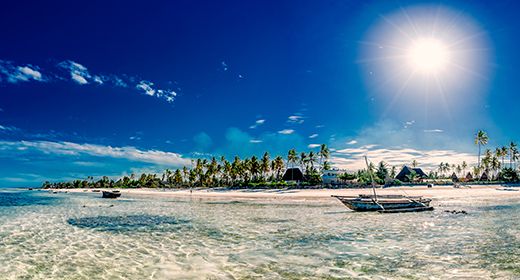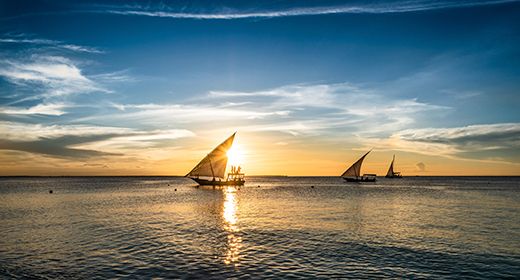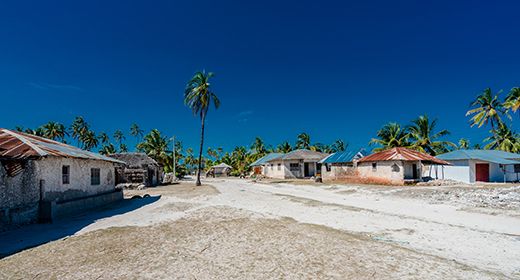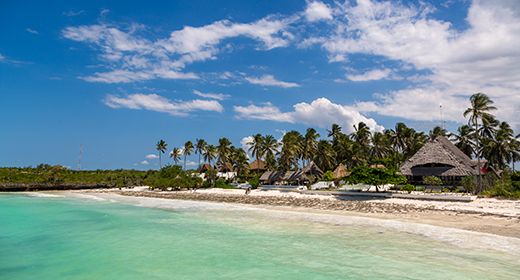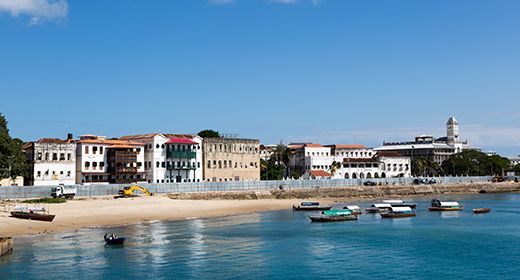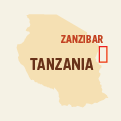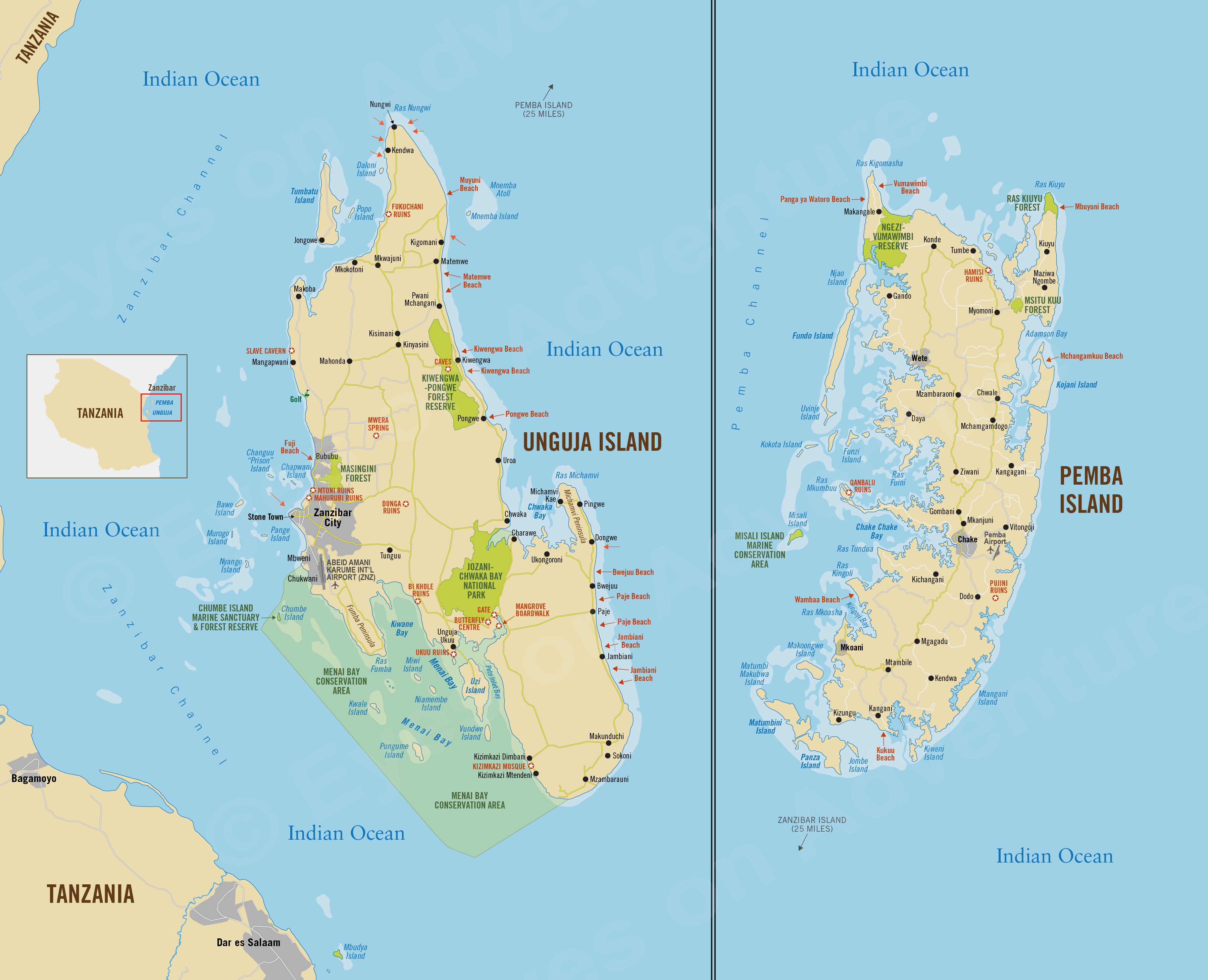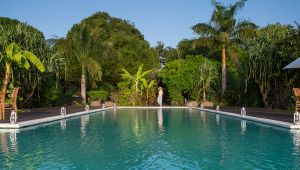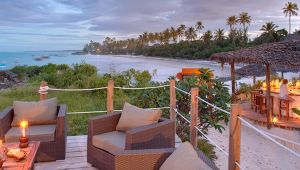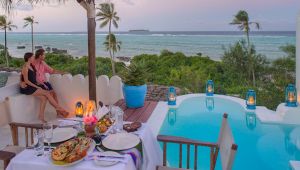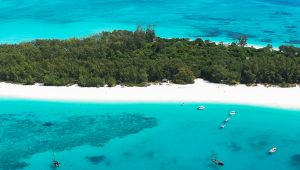Zanzibar
(incl. Unguja Island, Pemba Island, Stone Town)
Region Links: Great Migration, Kilimanjaro & Arusha, Ngorongoro & Manyara, Serengeti, Southern Tanzania, Tarangire, Western Tanzania, Zanzibar
Highlights
- Stone Town, the historic section of Zanzibar City
- Day safaris into Jozani Forest to see Zanzibar's wildlife and flora
- Scuba diving in the pristine Indian Ocean waters
- Numerous beaches for fun, sun, relaxation and water sports
- Spice tours and historic tours around Stone Town
EOA Recommends: Anna of Zanzibar, Essque Zalu Zanzibar, Fundu Lagoon Boutique Hotel, Mnemba Island, The Residence Zanzibar
The name Zanzibar evokes feelings of exotic islands, beautiful beaches, tropical air, a rich history of spice, slave and ivory trading, diverse cultures, and warm Indian Ocean waters. A visit to the islands is a great add-on to a wildlife safari.
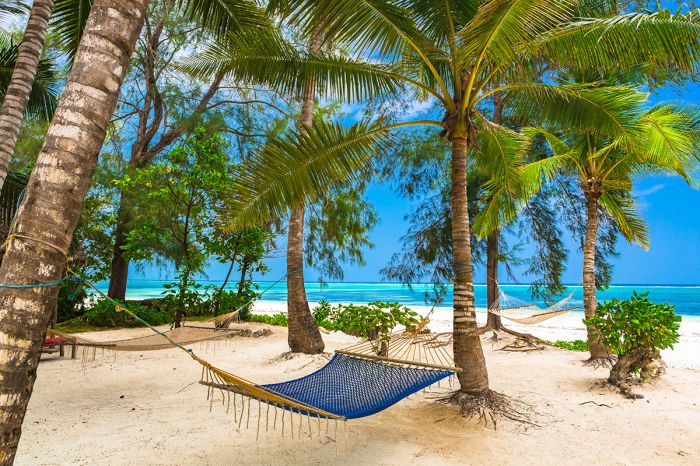
Zanzibar is a great place to relax and enjoy the warm, tropical air.
Zanzibar is an archipelago in the Indian Ocean, situated just offshore from northern Tanzania and consisting of over 50 islands. The two largest and most visited of these are Pemba and Unguja (which is also known as Zanzibar Island). Once the home of slave traders and sultans, today the islands attract tourists intent on discovering the pristine beaches, coral reefs, historic ruins, culture, and cuisine.
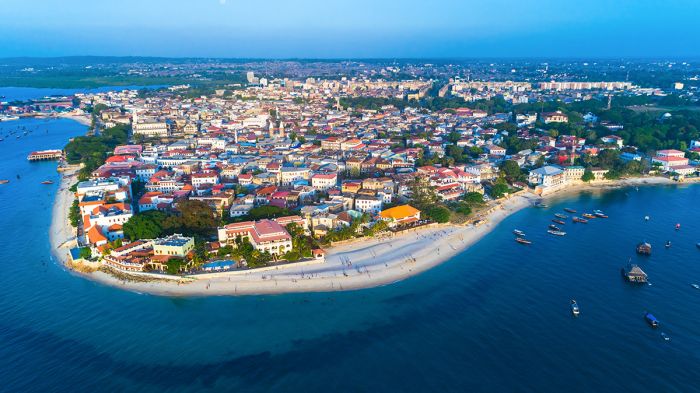
Aerial view over Stone Town on Unguja Island.
Unguja is home to the capital (Zanzibar City) and to Stone Town, the historic old quarter, which is a UNESCO World Heritage Site. Stone Town is the highlight for most visitors, with its narrow streets (most too narrow for cars) and historic buildings that date back to the booming slave trade of the 1800s.
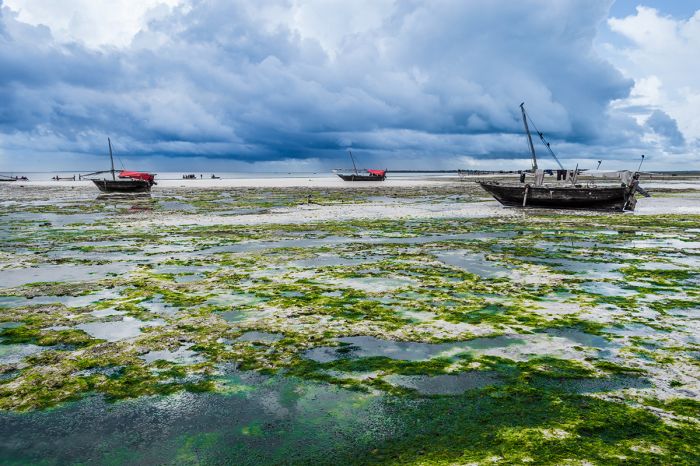
Boats on Kizimkazi beach, Unguja Island, Zanzibar.
Located 25 miles (40 kms) northeast of Unguja, Pemba is dubbed the Green Island and is best known for its abundance of clove trees and its world-class SCUBA diving. Seldom visited (most tourists opt for Unguja only), Pemba retains its old world feel and is mostly unchanged over the past century, making it feel like a step back in time.
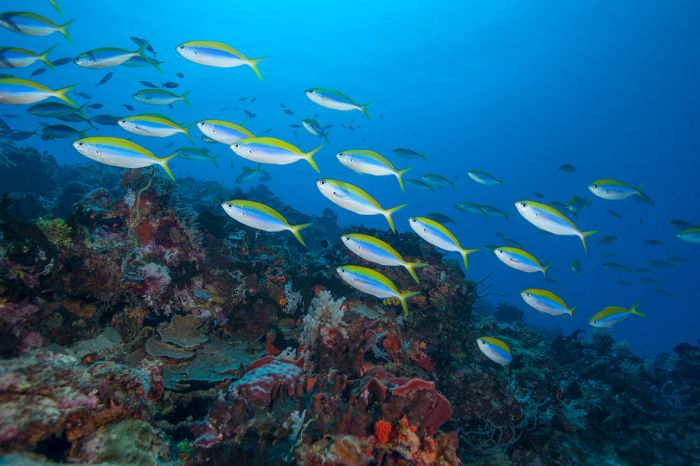
The coral reefs offshore from Pemba Island offer world-class diving.
A stay in Zanzibar is often added on to a safari itinerary, offering a taste of old-world culture, tropical relaxation, snorkeling, diving, and beaches after the dust and game drives in the Serengeti, Ngorongoro or elsewhere in Tanzania.
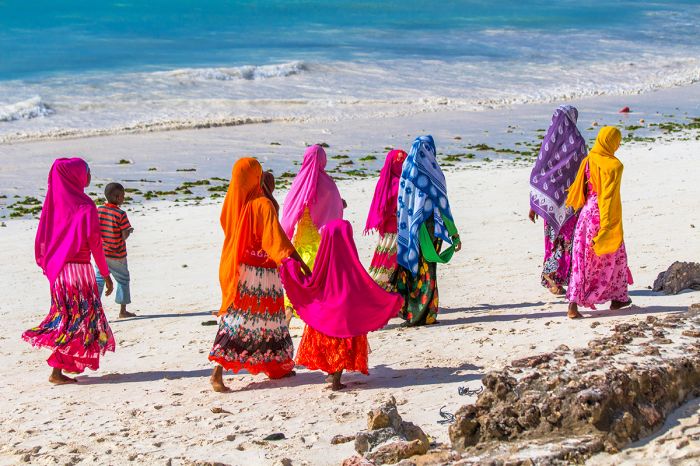
Locals on the beach in Zanzibar.
Read More...
Beaches, Chake, Changuu, Chapwani, Chumbe, Diving, Fumba, History, Jambiani, Jozani-Chwaka Bay, Kendwa, Kiwengwa, Kiwengwa-Pongwe, Kizimkazi, Mahurubi, Mangapwani, Matemwe, Menai Bay, Misali, Mnemba, Mtoni, Ngezi-Vumawimbi, Nungwi, Pemba, Pujini, Ras Kigomasha, Snorkeling, Stone Town, Unguja, Zanzibar Archipelago, Zanzibar City
History
Early Stone Age tools discovered on the Zanzibar archipelago indicate that humans have inhabited Zanzibar for at least 20 000 years. Coastal Tanzania and Zanzibar have been home to Bantu speaking tribes since the beginning of the first millennium.
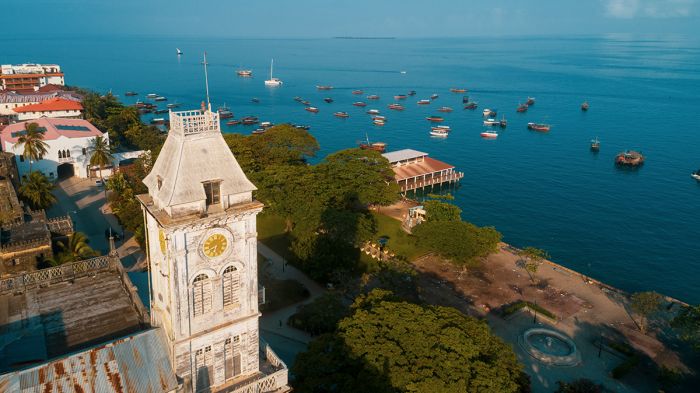
View over the waterfront of Stone Town on Unguja Island, Zanzibar.
It is known from archeological finds and early Greco-Roman texts that ships from Arabia, Persia (Iran), and India have traded at Zanzibar for around 2 000 years. Archeological discoveries at Fukuchani, on Unguja's northwest coast, include shards of imported pottery from Arabian cultures dating back to the 5th century. Fukuchani was the site of an early agricultural and fishing community.
Trading with ships from the East became increasingly important to African cultures beginning in the mid-8th century and by the 10th century, Zanzibar had become home to groups of immigrants from Persia and Arabia, who commingled with the local Swahili on the islands. Traders from the east increasingly used Unguja as a base for maritime journeys, settling in present-day Stone Town.
The Zanzibar Archipelago have long produced cloves, nutmeg, cinnamon, vanilla, and black pepper and together with Mafia Island, further south along Tanzania's coast, became known as the "Spice Islands".
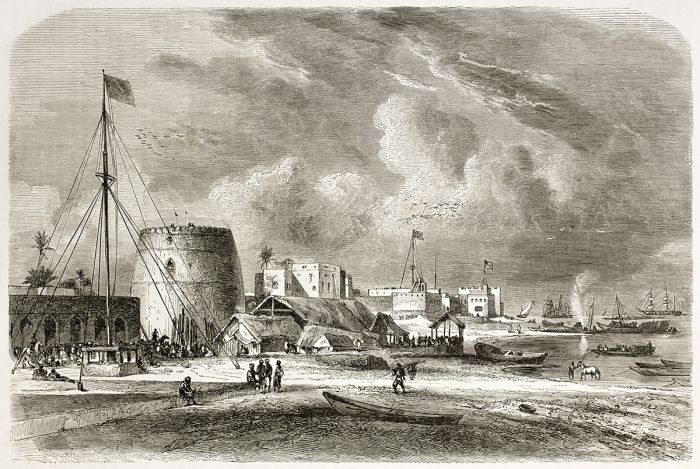
Artist's depiction of the port of Zanzibar City in 1860.
The first Europeans to visit Zanzibar were members of the famous Portuguese expedition to Africa and India, which was led by Vasco da Gama and stopped over in the islands in 1498. In 1503, Portugal took control of Zanzibar and it remained so for the next two centuries. Relations between the Portuguese and the local Arab and Swahili elites were often hostile and Portuguese influence in the islands was relatively limited, leaving administration mostly in the hands of local leaders.
In 1698, the Sultanate of Oman gained control of Zanzibar. During the first half of the nineteenth century, various Omani merchant princes settled on Zanzibar as elite rulers and landowners, and in 1840, Said bin Sultan, the Sultan of Muscat and Oman, moved his capital from Muscat, Oman to Stone Town on Unguja Island. Unguja became an Arab state and the focus of a burgeoning slave, ivory, and spice trade.
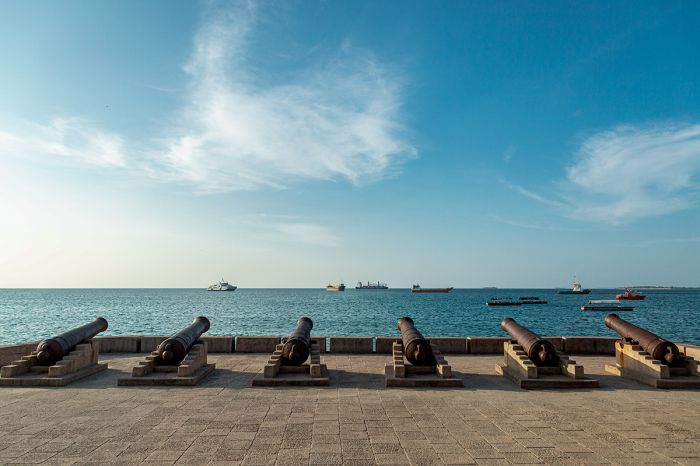
Historic canons overlooking the harbor at Stone Town.
The Sultan died in 1856 and his empire was divided between his two sons, with one son, Thuwani bin Said, becoming Sultan of Oman, and the other son, Majid bin Said, becoming Sultan of Zanzibar. Zanzibar's Sultan consolidated his power around the African slave and ivory trade. Zanzibar City became the main trading port for slaves and ivory, which were obtained from the African mainland as far west as the Congo Basin and shipped to the Middle East. An estimated 50 000 slaves and untold tons of elephant tusks passed through Zanzibar during the mid-19th century.
Until the late 1880s, the Sultan of Zanzibar controlled much of Africa's Swahili Coast, which included Mombasa and Dar es Salaam; however, Germany and Britain were plotting to colonize this region of the continent. During the late 1880s, Germany and Britain divided up control and ownership of most of East Africa and in 1890, Zanzibar became a British protectorate, but not a colony. This distinction meant that Zanzibar continued to be under the sovereignty of the Sultan of Zanzibar.
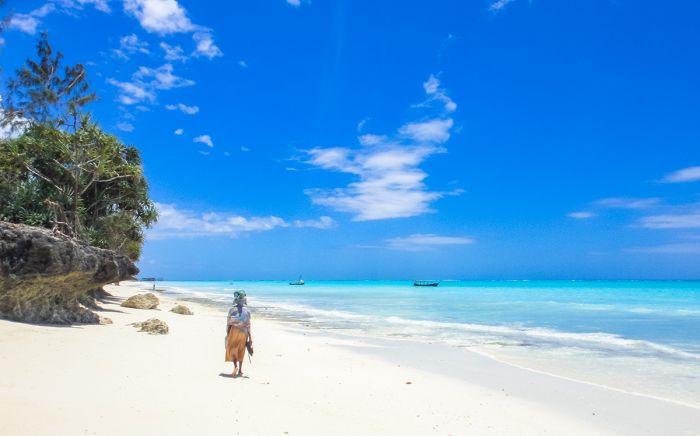
Beach scene on Unguja Island, Zanzibar.
Zanzibar gained independence from Britain in December 1963, leaving it under full control of the sultan. One month later, in January 1964, Jamshid bin Abdullah, the reigning sultan, was overthrown in a revolution and fled into exile. Over 20 000 people were killed and refugees, mainly Indians and Arabs, were forced to leave the islands.
In April 1964, Zanzibar was merged with Tanganyika (mainland Tanzania), which had gained its independence from Britain in 1961, into the newly created United Republic of Tanganyika and Zanzibar. The new state changed its name to the United Republic of Tanzania within a year.
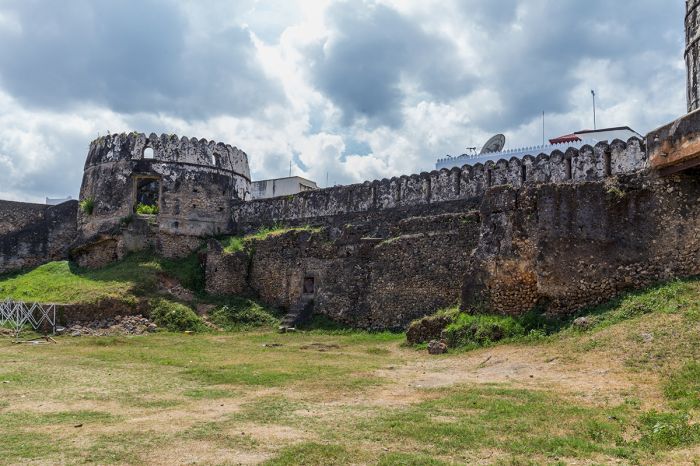
The Old Fort, Stone Town, Zanzibar Island.
Today, the people living on the islands are a mixture of the original Bantu-speaking "Swahili" Africans and descendants of the various Eastern cultures and slaves that have passed through the islands during modern history. These descendants of Arabs, slaves, and Africans call themselves "Shirazi".
The indigenous islanders are commonly described as three main groups: the Bantu-speaking Hadimu, who live mainly in southern and central Unguja, another Bantu-speaking people known as the Tumbatu, who inhabit northern Unguja and Tumbatu Island, and the Pemba of Pemba Island.
Swahili is the principal language spoken on the islands, with a local dialect called Kiunguja. Arabic is also important, owing to the long-established Muslim influence. English is also widely spoken. Tradtional African beliefs are combined with the Islamic faith throughout the islands.
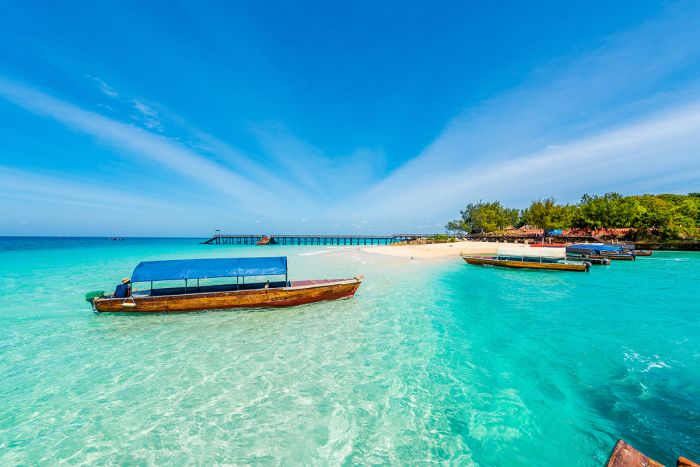
Traditional boats in Zanzibar.
Zanzibar Archipelago
Zanzibar consists of two main islands and about 50 much smaller islands lying 25-50 miles (40-80 kms) offshore from the northern coast of Tanzania, which is known as the Swahili Coast.
Most of Zanzibar's population, which numbers around 1.1 million, live on its two largest islands, Unguja (also known as Zanzibar Island) and Pemba. Roughly two-thirds live on Unguja, while most of the rest live on Pemba. Small numbers live on Tumbatu, Fundo and some of the other small islands in the archipelago.
Zanzibar is a semi-autonomous region belonging to the Republic of Tanzania, with its own government.
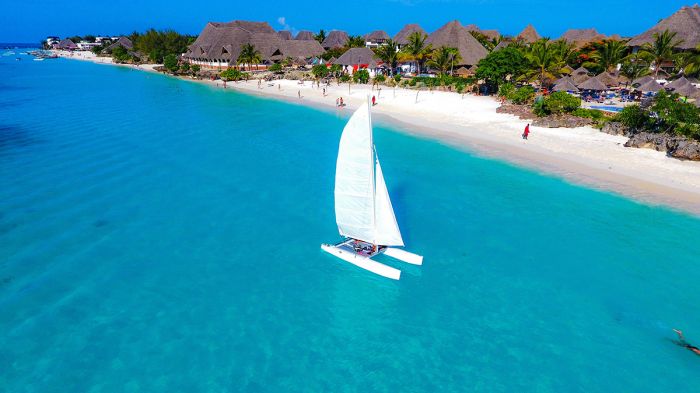
Beach resort scene in Zanzibar.
Unguja Island
Zanzibar's main island is Unguja, also sometimes called Zanzibar Island. The island covers an area of 643 square miles (1 666 sq kms), measuring 53 miles (83 kms) north-to-south and 19 miles (30 kms) east-to-west at its widest.
Zanzibar's capital is Zanzibar City, located on the west coast of Unguja and the only significant urban center on the islands. Zanzibar's top tourist draw is Stone Town, the old Arabian-style quarter of Zanzibar City.
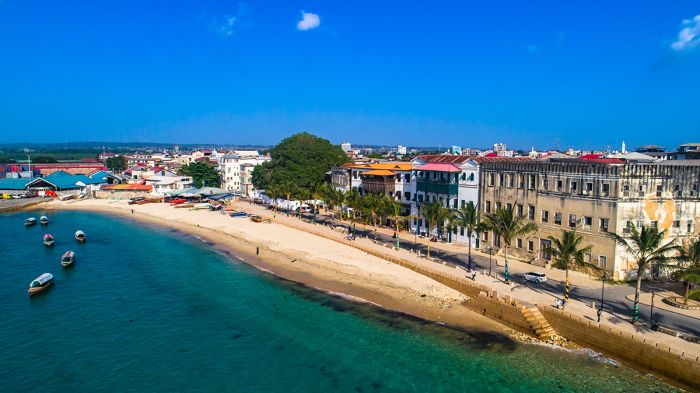
Stone Town on Zanzibar (Unguja) Island.
Stone Town
Stone Town is the oldest section of Zanzibar City, located on a small peninsula and dating back 150 years. It is known locally as "Mji Mkongwe", meaning Old Town and is very similar in appearance to North African 'medinas', with Arabian-style architecture, mosques, narrow winding streets, shops and busy bazaars selling various goods. A guided walking tour of Stone Town to discover its slave-trading history is highly recommended, but wandering the streets and visiting the markets on your own is also a pleasure.
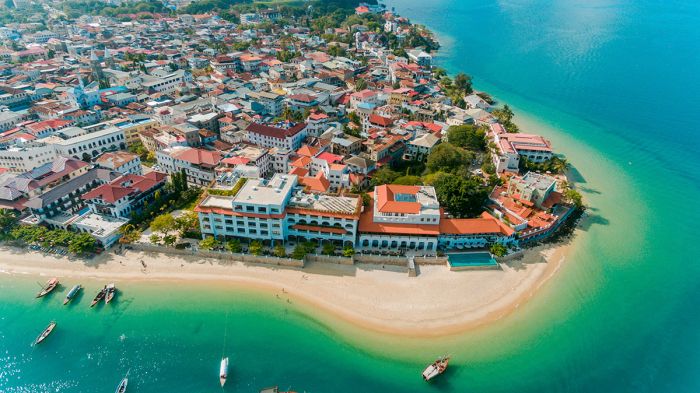
Aerial view over the Stone Town waterfront.
Stone Town became a UNESCO World Heritage Site in 2000; however, many of the town's historic buildings are in deteriorating condition due to the humid ocean climate and the fragile nature of coral stone, which is used in much of the older landmark buildings. Major restoration projects are constantly underway.
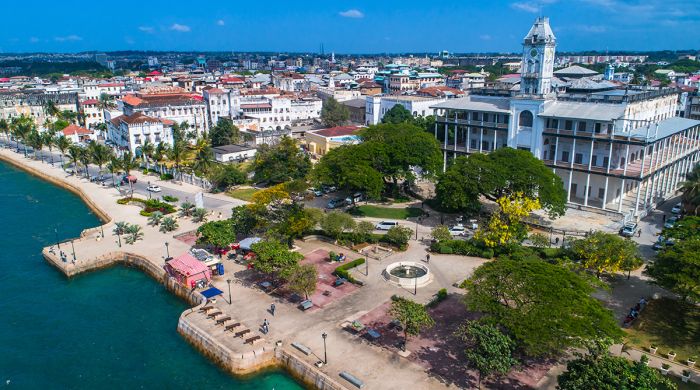
Stone Town's waterfront.
Some of Stone Town's must-see landmarks include the following...
The Old Dispensary, a spectacular four-level building built in 1887 to celebrate Queen Victoria's Golden Jubilee. It is one of Stone Town's most elaborate structures and located along the seafront. It fell into ruin after the 1964 revolution, but was beautifully restored in 1994 and today is mostly occupied by offices. It is one of Zanzibar's top tourist attractions.
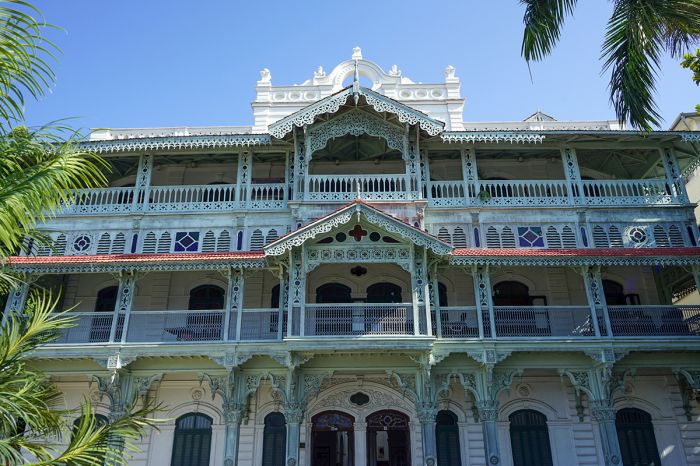
The Old Dispensary in Stone Town, Unguja Island, Zanzibar.
The Palace Museum, located just south of the Dispensary, was built in the late 1800s and served as the residence of the last Omani sultan, who was exiled in 1964. The museum is open daily and houses historical furniture, writings, clothes, and daily life items showing the lifestyle of the Omani elite during the 19th century.
The House of Wonders (Beit al-Ajaib), is perhaps Unguja's most impressive landmark structure. Located along the seafront and constructed in 1883, it is one of six palaces built by Barghash bin Said, the second sultan of Zanzibar. It was at that time, the tallest building in East Africa and also the first to have electric lighting, running water, and even an elevator.
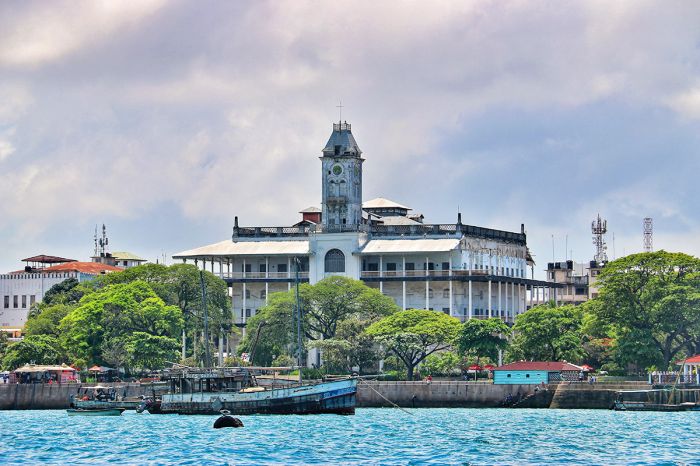
Stone Town's House of Wonders, viewed from the harbor.
Also located along the seafront is The Old Fort (Ngome Kongwe), Zanzibar's oldest standing structure, dating back to the ousting of the Portuguese by the Omani in 1698. The fort was quickly constructed and completed by 1701. It was later used as a prison and army barracks and today houses craft shops, an open-air amphitheater that hosts regular events, and a restaurant.
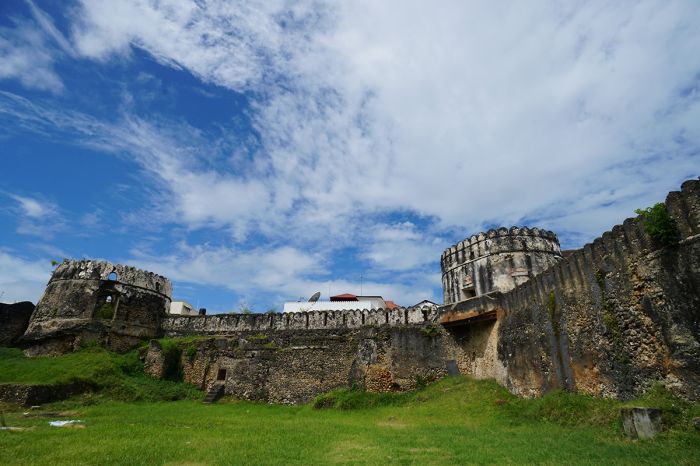
The Old Fort in Stone Town, Zanzibar.
Forodhani Gardens, also called the Jubilee Gardens, are located along the main seawalk. The name (meaning "a ship's cargo") refers to the slave trade that was so prevalent here in the 19th century. The gardens host a popular open-air street food market, which opens daily after sunset, serving Zanzibari cuisine like grilled seafood, samoosas, sweet potatoes, and cassava.
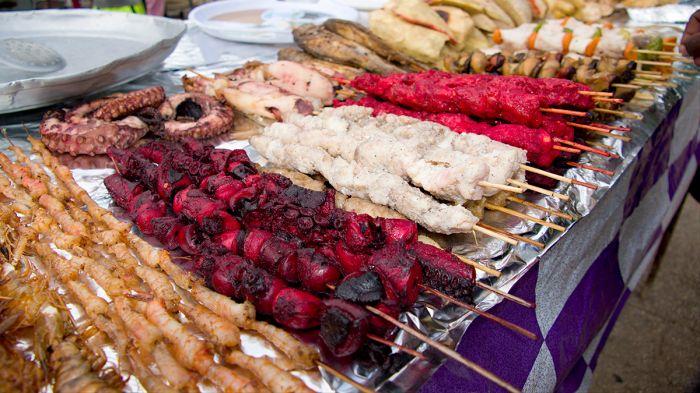
Grilled seafood at the Forodhani Gardens street market.
Kelele Square, the name meaning "tumultuous", was Zanzibar's open-air slave market in the 19th century. Located at the westernmost tip of Stone Town, the square is surrounded by some hotels and cafes.
Tippu Tip's House, with its elaborate door, is another must-see landmark of Stone Town. Tippu was an Arab-Zanzabari slave and ivory trader who worked with a succession of the sultans of Zanzibar. His caravans into Central Africa are legendary and he became the leading slave trader on the continent.
There are many more sights to see and a guided walking tour of Stone Town is well worth the time.
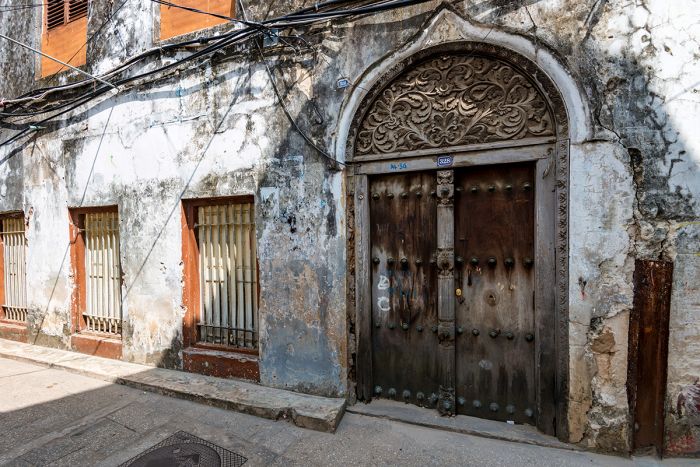
A typical house with an ornate door in Stone Town, Zanzibar.
Southern Unguja
Unguja's south is characterized by its beautiful beaches, great snorkeling and diving. It is much less crowded than the far north, with far fewer accommodations and tourists.
Jozani-Chwaka Bay National Park
Jozani-Chwaka Bay is Zanzibar's only national park and its premier terrestrial conservation area. The park covers 19 square miles (50 sq kms) and is home to spectacular forest and the endangered Kirk's red colobus monkey, which is almost a guarantee to be seen. Other large mammals living in the forest includes the blue (or Sykes') monkey, Ader's duiker, suni antelope, and bush pig. Smaller animals include the elephant shrew, bush baby, various chameleons, over 40 species of bird, and over 50 species of butterfly.
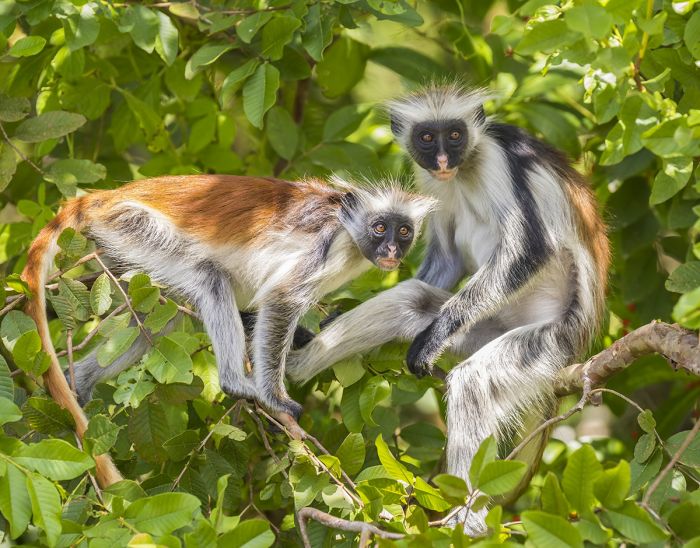
The endemic Zanzibar red colobus monkey in Jozani-Chwaka NP.
The park offers several enjoyable nature trails that range in duration from one hour to a half-day hike that are an excellent way to explore the forest at any pace you desire. The park also extends beyond the forest and into Chwaka Bay, with its sea-grass beds and intertidal zones, fringed with mangrove forest.
South of the park entrance gate is the Pete-Jozani Mangrove Boardwalk, a short, highly recommended stroll. The park entrance fee includes the services of a guide (optional). The nearby Zanzibar Butterfly Centre offers visitors a look at some of the butterfly species native to Jozani.
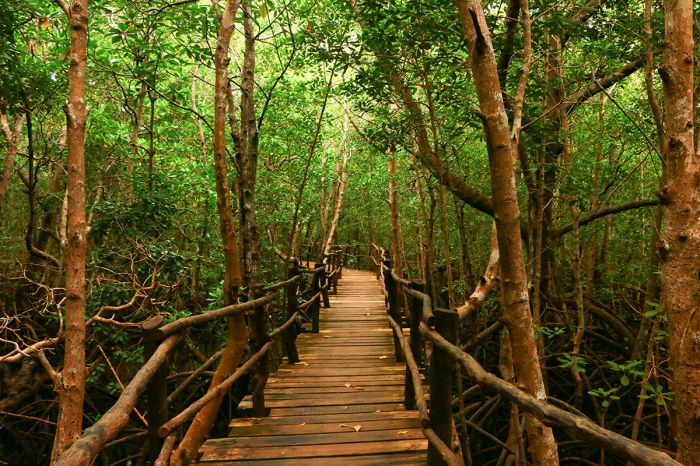
Walking trail in Jozani-Chakwa National Park, Unguja.
Menai Bay Conservation Area
The entirety of southern Unguja's coastline is protected as part of the Menai Bay Conservation Area (MBCA). Covering 180 square miles (470 sq kms) of coastal waters, the MBCA is Zanzibar's largest marine protected area. The MBCA protects a variety of habitats including coral reefs, sea grasses, mangrove forests, beaches, and sandbanks, plus plentiful marine life, including bottlenose dolphins and Indo-Pacific humpback dolphins.
The MBCA was created in 1997 as a World Wildlife Fund initiative and it has been deemed a huge success. The villages at Kizimkazi, which previously harvested large numbers of marine animals, including dolphins, now benefit from tourism, especially boat-based dolphin tours.
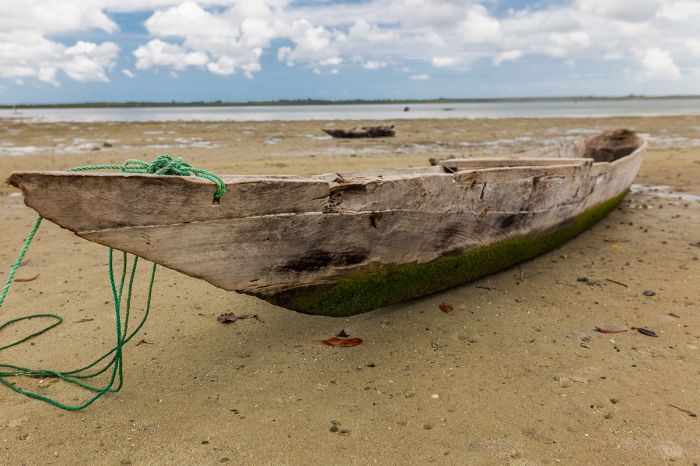
Traditional fishing boat on Uzi Island in Menai Bay, Unguja.
Kizimkazi
Near the southernmost part of Unguja are the twin-towns of Kizimkazi, known for dolphin tours in Menai Bay and for being the longest continually inhabited settlement in Zanzibar, where the Wawinyi Wakuu, the last of Zanzibar's pre-Omani rulers, lived over 1 000 years ago. Kizimkazi is also the site of Eastern Africa's oldest mosque, which dates back to 1107 AD. The mosque is open to tourists.
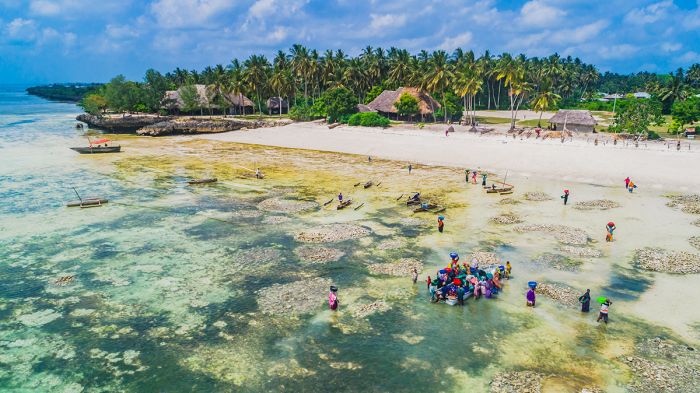
Beach at Kizimkazi on Unguja Island.
Fumba
The Fumba Peninsula extends into the northern portion of Menai Bay and offers beautiful and deserted coastline with sandy coves accessed by stairs down to the beach. Snorkeling here is superb.
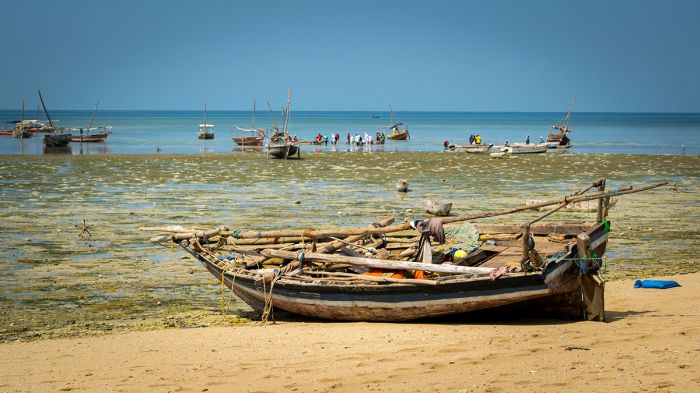
Seascape at Ras Fumba, Unguja Island, Zanzibar.
Jambiani
The southeastern coast of Unguja is best known for Jambiani, a 4-mile-long (7-km) beach and village that offers superb snorkeling in shallow water, with sandbanks and coral reefs. This stretch of coast is quite tidal, so swimming is only available at high tide. The beach is backed by plenty of restaurants, lodging and village life. Once the most crowded beach on Unguja, these days the crowds flock to Nungwi in the far north, so Jambiani and Page are much more peaceful.
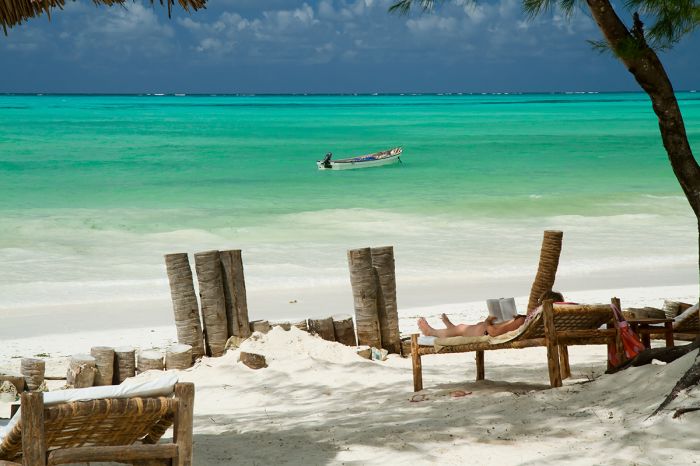
Paje beach, north of Jambiani on Unguja's east coast.
Just north of Jambiani beach is Page beach, another long white-sand beach, beginning south of the village of Paje and stretching uninterrupted for 8 miles (13 kms), all the way through and past the villages of Bwejuu and Dongwe where the Michamvi Peninsula begins. Ras Michamvi, at the northern tip of the peninsula, is a high headland with stunning views, small sandy coves down at the ocean, and various boutique accommodations.
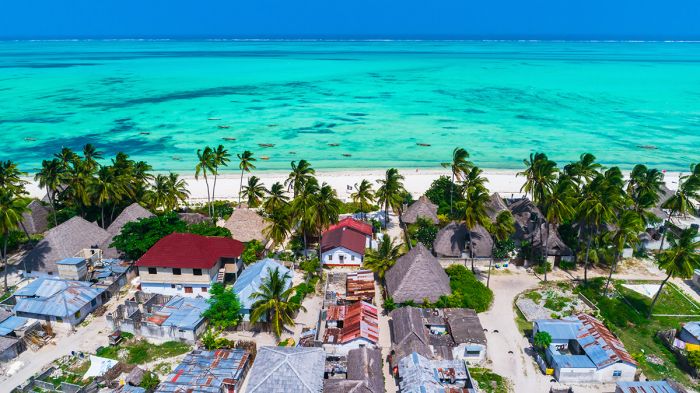
View over Jambiani Beach on the southeast coast of Unguja.
Northern Unguja
The northern region is Unguja's most popular beach resort destination. Snorkeling, diving, beaches and water sports are the main attraction, but the bustling towns of Nungwi and Kendwa on the far northern cape also offer a nightlife scene.
Nungwi and Kendwa
The northern tip of Unguja, around the traditional fishing and dhow-building village of Nungwi, has become Zanzibar's most popular tourist retreat, owing to the myriad water sports available including superb snorkeling and diving. Once an enclave for hippies, Ras Nungwi has emerged as the place to be on Unguja, with a multitude of accommodations, seafood restaurants, and a lively nightlife scene.
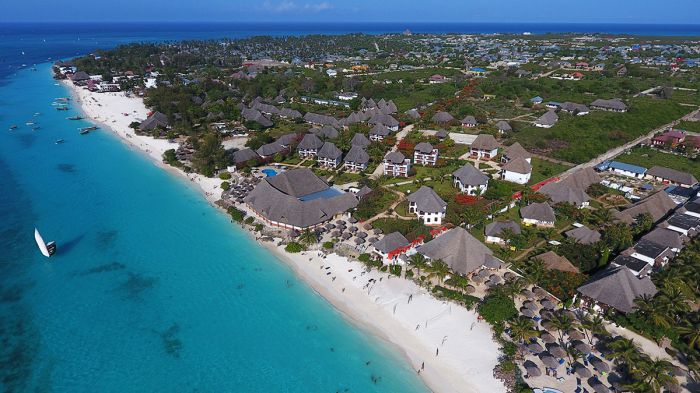
Beach resorts on Ras Nungwi, northern Unguja, Zanzibar.
The two main stretches of beach are located on the western side of the cape and this is where the hotels, restaurants, and bars are located. The coast between the villages of Nungwi and Kendwa is the hub of tourist activity and snorkeling, diving, windsurfing, dhow cruises, and other water-sports can be arranged from any accommodation. Diving can be booked at one of the PADI-accredited dive centers.
The eastern shoreline of Nungwi is mostly deserted and very peaceful, with no facilities besides a few upscale lodges, making it a romantic destination free from the hectic crowds across the peninsula.
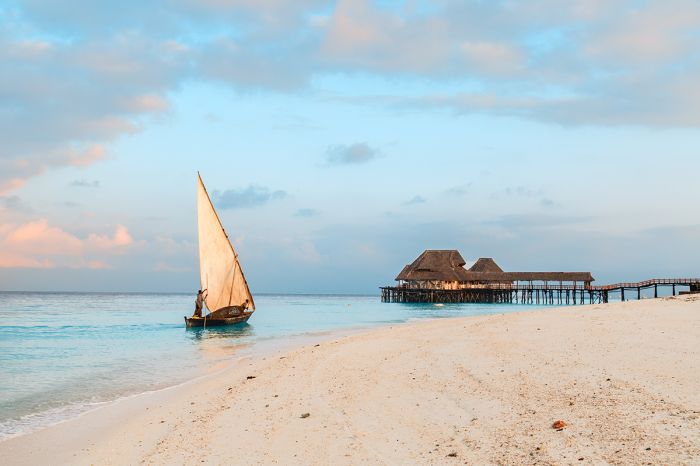
Beach scene at Kendwa in northern Unguja.
Despite the bustling tourist industry, Nungwi itself is still a fishing village and traditional dhow-building is still a local specialty. The daily fish market is worth visiting when the fishing boats return and the romantic view of the traditional outrigger boats helps retain the old-world feel. The Ras Nungwi lighthouse was built in 1886 and the Mnarani Aquarium is also worth a visit. Cultural Village Tours are a good way to see everything with a knowledgeable guide.
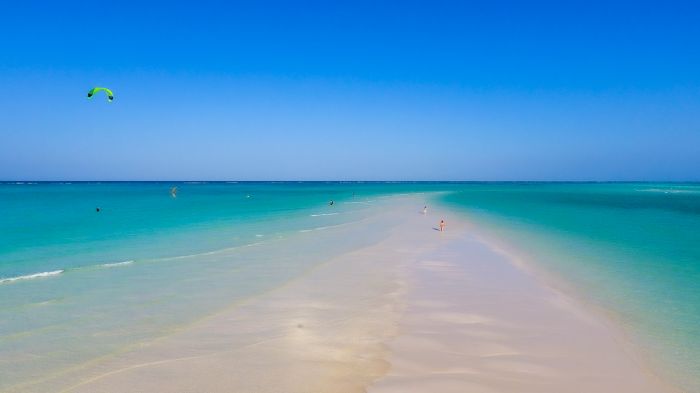
Beautiful beach with kite surfers at Ras Nungwi, northern Unguja.
Mnemba Island
Located just 1.5 miles (2.5 kms) off the northeast coast of Unguja is the tiny island of Mnemba, which is part of the mostly submerged Mnemba Atoll. The entire island is now a private and exclusive resort retreat. Pristine beaches, a small forest, and superb snorkeling and diving are on offer.
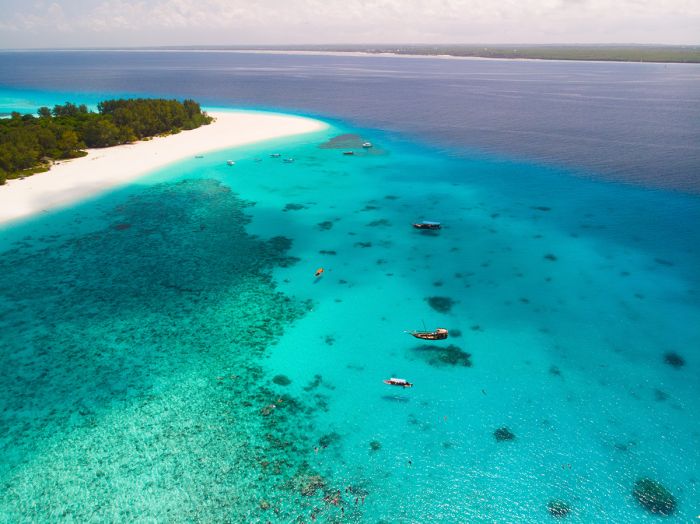
Excellent snorkeling on the reef at Mnemba Island .
Matemwe
Matemwe is one of the most pleasant beaches on the eastern shoreline, with palm trees, wide white sands, and intimate village life. The snorkeling and diving on the reef is superb.
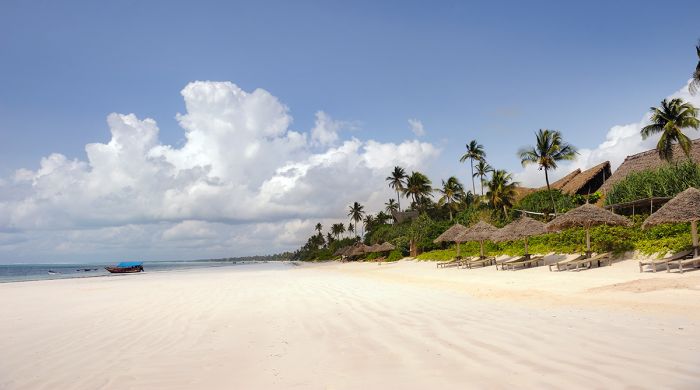
Idyllic seascape at Matemwe beach, northeast Unguja Island.
Kiwengwa
Zanzibar's packaged-vacation destination is the stretch of coastline between Kiwengwa and Pwani Mchangani. This lovely stretch of beach is dominated by all-inclusive resorts catering mostly to Europeans. There are however some very good, smaller hotels worth considering.
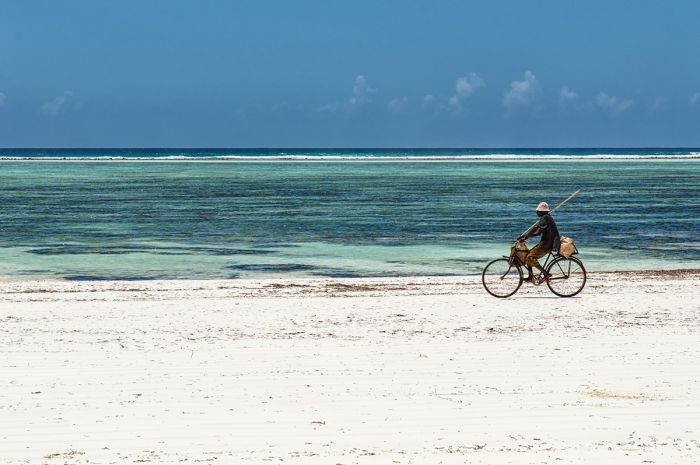
A local villager on the beach at Kiwengwa.
Kiwengwa-Pongwe Forest Reserve
Kiwengwa-Pongwe is a 13-square-mile (33-sq-km) conservation area that protects one of Unguja's most biodiverse habitat, including coral rag forest, which grows atop the rubbly limestone of an ancient coral reef. Wildlife in the reserve includes the endangered Zanzibar red colobus, blue and Sykes' monkeys, bushbaby, and Ader's duiker antelope. There are around 50 series of bird living in the forest.
Several nature trails are available for visitors to explore, as well as the limestone Mchekeni Caves, which are coral caverns in what used to be offshore coral reefs. The Reserve was created in 2009 to provide conservation education and revenue to the local villagers and encourage them not to take wood from the forest. A beekeeping initiative is also underway to support the nearby villages. By visiting the forest, you will help preserve it.

The endemic Zanzibar red colobus monkey is found in Kiwengwa-Pongwe.
Zanzibar City and Surrounds
Zanzibar City (also called Zanzibar Town) is the capital and largest city on the islands. The city is comprised of two sections, Stone Town, which is the oldest section, and Ng'ambo (meaning "The Other Side"). The two parts are separated by a long-drained creek, which is now Creek Road. Abeid Amani Karume International Airport, located 3 miles (5 kms) south of the city, is the main gateway to the islands.
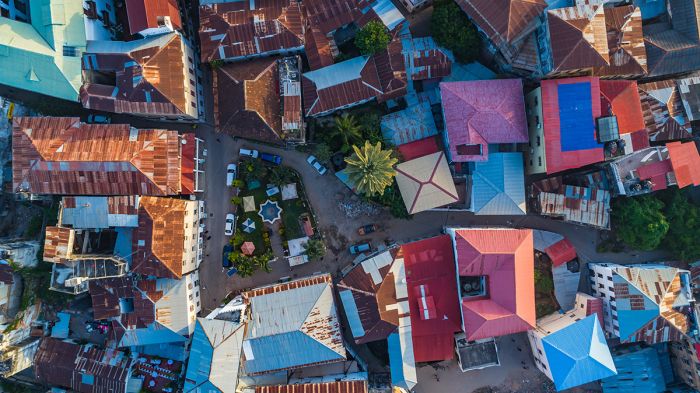
Colorful rooftops in Stone Town, Zanzibar City.
Spice Tours
One of the most obligatory activities in Zanzibar is a Spice Tour. The tours generally take a walking exploration of a nearby spice farm, finishing with a local meal.
Changuu Island
Also known as Prison Island, Changuu a small narrow island located 3 miles (5 kms) offshore from Stone Town. The island was once used as a staging grounds for slaves en route from the mainland. A large colony of fenced-in Aldabra giant tortoises lives on the island. Half-day and full-day tours include snorkeling at nearby Bawe Island.
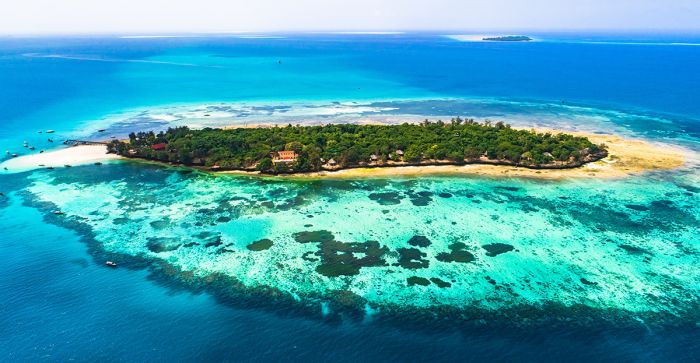
Changuu (Prison Island) off the coast Unguja.
Chumbe Island
Located just offshore and south of Zanzibar City, Chumbe Island offers spectacular snorkeling, with more than two hundred species of stone coral and hundreds of species of fish. The island is covered in coral rag forest and can be explored on hiking trails. Both the island and the waters and reefs offshore are protected as the Chumbe Island Marine Sanctuary & Forest Reserve.
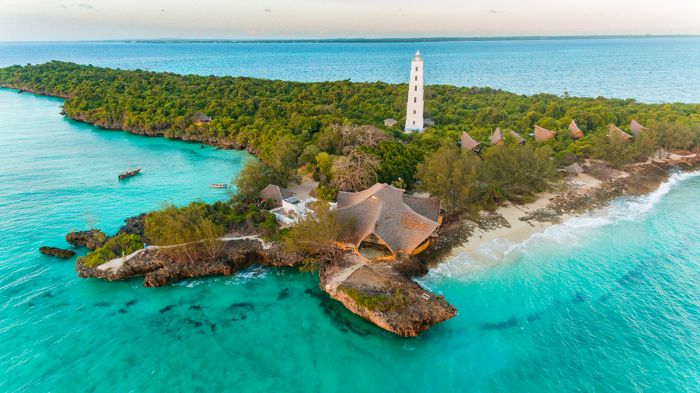
Chumbe Island Marine Sanctuary.
Chapwani Island
Also known as Grave Island, Chapwani is a long and narrow strip just offshore from Stone Town and is a popular day-trip destination for its Christian cemetery, which was founded in 1879. The graves are mostly those of British sailors, some killed fighting the Arabs and others who died when the Pegasus, a British ship, sank here during World War I. The indigenous forest can be explored and there is a good swimming beach.
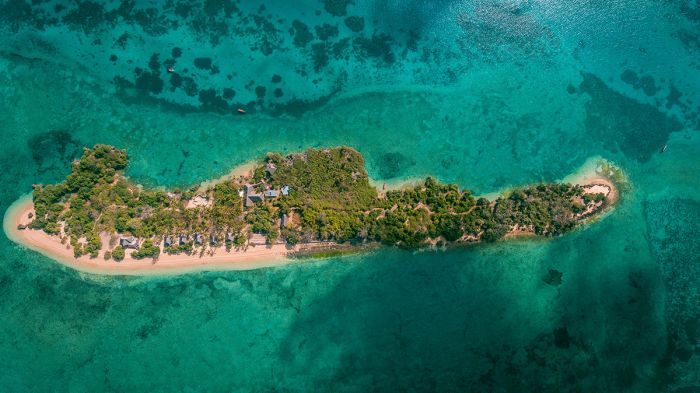
Chapwani Island, Zanizibar.
Maruhubi and Mtoni Ruins
The coastline north of the city were a preferred residential location for the various sultans of Zanzibar. The ruins of burned-down palaces still exist and are interesting to explore.
Located only a mile (3 kms) north of Stone Town, Mahurubi Palace was built by Sultan Barghash in 1882 as a residence for his wife and ninety-nine concubines. Mahurubi burned in 1899.
Another kilometer north are the Mtoni Palace ruins. Built between 1828-1832 by Sultan Sayyid Saïd, the palace burned in 1914. Mtoni housed the sultan's wives, children, and hundreds of concubines. Mtoni is most famous for being home to Princess Salme, one of the sultan's daughters, who eloped with a German merchant in 1866, causing a huge scandal.
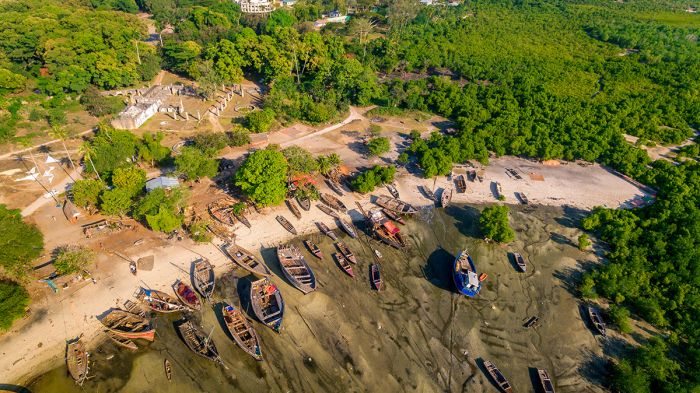
Mahurubi historical ruins on Unguja Island, Zanzibar.
Mangapwani
Located 15 miles (25 km) north of Stone Town is the coastal fishing village of Mangapwani. It is notorious for being the location for the black-market slave trade after slavery with the African mainland was outlawed by the British in 1873. Man-made chambers dug into the shore were used to the hide the illegal slaves from anti-slavery patrols. The caves are small and claustrophobic cells and can be viewed on a tour or on one's own.
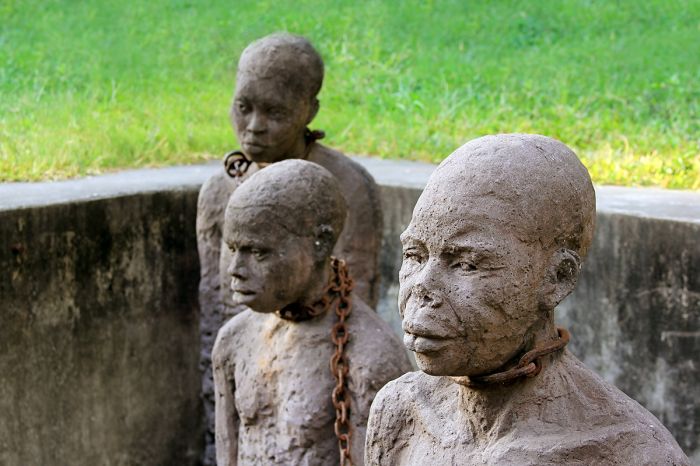
Slave Trade Memorial, Stone Town, Zanzibar.
Unguja beaches
The beaches along Unguja's eastern coast are often covered in pungent seaweed between November and February, but the more upscale hotels clear their beaches. Another consideration is that almost all of the east coast beaches are highly tidal and have barrier reefs extending out several kilometers, so swimming is possible only at high tide.
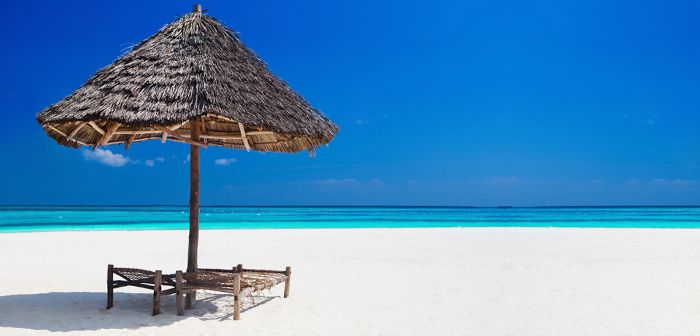
A beautiful beach scene in Zanzibar.
Pemba Island
Located 25 miles (40 kms) northeast of Unguja lies Zanzibar's oft overlooked 'other' big island, Pemba. Often called the "Green Island", owing to its lush and densely vegetated landscape, the island covers an area of 381 square miles (988 sq kms), measuring 42 miles (67 kms) north-to-south and 14 miles (22 kms) east-to-west at its widest.
Pemba is a low-lying, but hilly island, with a maximum elevation of 330 feet (100 meters). Cloves are the main agricultural product and the island has a permeating and fragrant spice aroma. Traditional medicine and witchcraft are still practiced on the island.
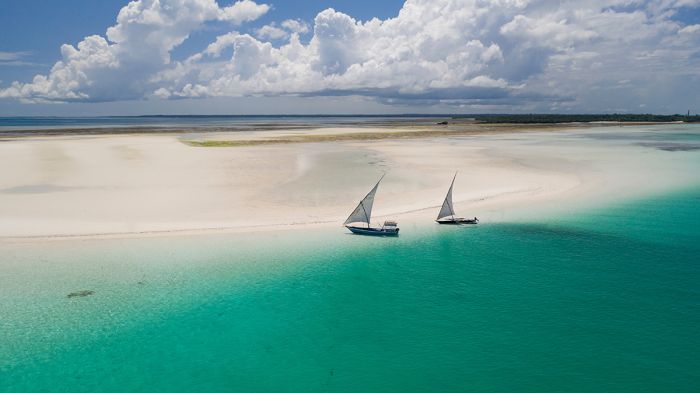
Idyllic scene with sailboats at a deserted beach on Pemba Island.
Pemba is infrequently visited, as it is not touted as a tourism destination by the Zanzibari government. Pemba's infrastructure is far less developed than Unguja, but is far quieter and retains a true old world feel. The three main towns on Pemba are Chake Chake (the capital), Mkoani in the southwest, and Wete in the northeast.
The island and its offshore reefs are best known for having numerous world-class dive locations. Pemba also offers lovely beaches and several ruin sites. There are also a handful of excellent accommodations for those who seek a comfortable, but more remote destination than Unguja.
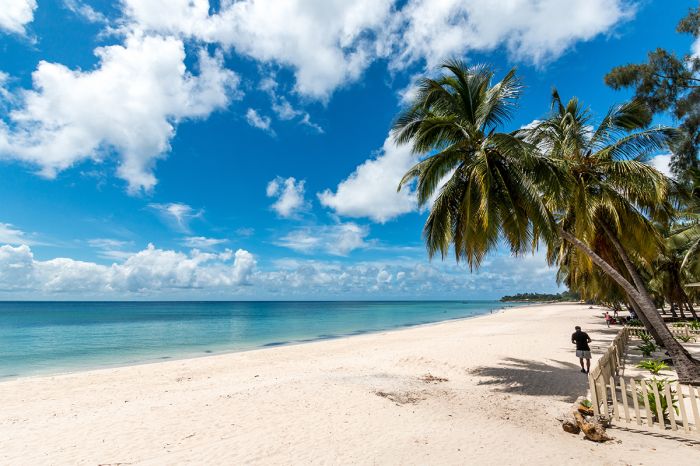
Beach scene on Pemba Island, Zanzibar.
Central Pemba
Chake
Chake Chake ("Chake" is commonly used) is Pemba's capital and largest city. Although centuries old, the town is rather unremarkable but untouristy and a pleasant place to visit. There is a daily market for spices, herbs, honey, oils and more. The ruins of Nanzim Fort, an 18th century structure built by the Omanis atop the original Portugueses Fort from 1594, is now a very nice museum.
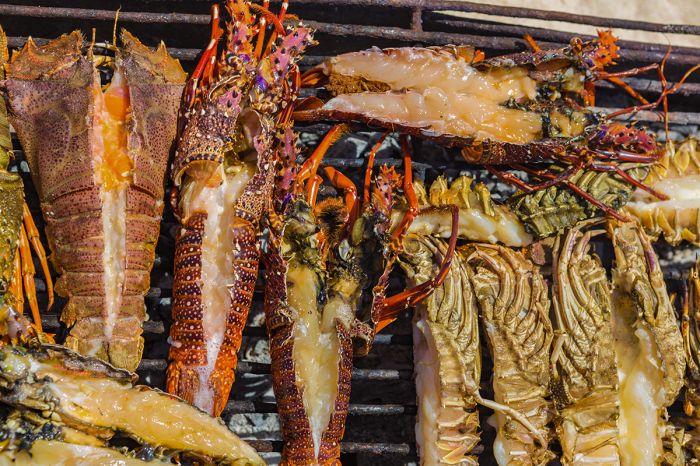
Grilled shellfish in Chake, Pemba Island.
Misali Island
Lying 10 miles (17 kms) offshore from Chake is Misali Island, one of Pemba's highlights. Misali offers beautiful beaches, excellent snorkeling and diving, and a lovely forest interior, with several hiking trails. The island is uninhabited and part of the Misali Island Marine Conservation Area, which protects the island and the diverse coral reefs surrounding it. Legend has it that the notorious pirate, Captain Kidd, used the island as a hideout and buried treasure here.
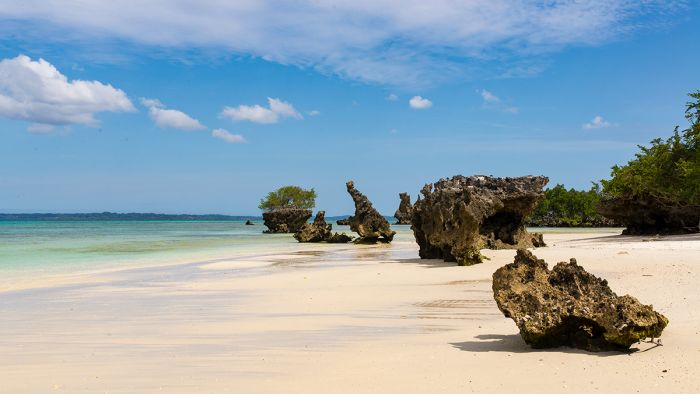
Beautiful beach on Misali Island, Zanzibar.
Pujini Ruins
About 6 miles (10 kms) southeast of Chake are the ruins of a 15th century settlement inhabited by the Diba people, who ruled over Pemba from the 15th-17th century. The remains include a citadel built by Mkama Ndume, a merchant/pirate and the ruins are often referred to by his name.
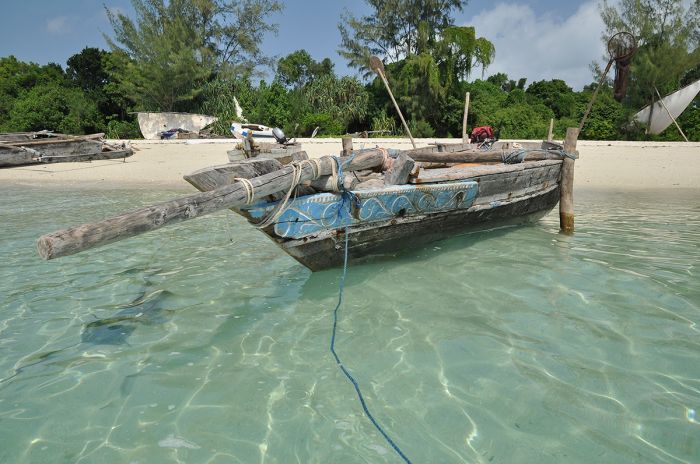
Traditional fishing dhow on Pemba Island.
Southern Pemba
The south of Pemba is sparsely populated, with a few good beaches and the island's third-largest town, Mkoani. Mkoani is Pemba's main seaport and the ferries from Stone Town and Dar es Salaam arrive here. There is not much else to the town other than a small market.
A walk to the sandy spit at Ras Mkoasha provides beautiful vistas. Boat tours leave from Mkoani to various nearby islands, including Makoongwe, Misali, and Panza for swimming, snorkeling, mangroves, birding, and more.
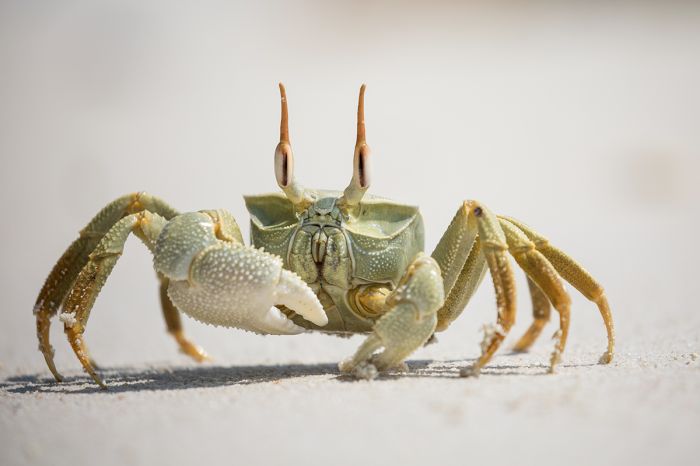
A horned ghost crab on the beach, Pemba Island.
Northern Pemba
The northern part of Pemba is lush and flat, with forests, small settlements, and cultivation of rice and cloves. The port town of Wete is Pemba's second-largest settlement, and is known for its traditional dhows.
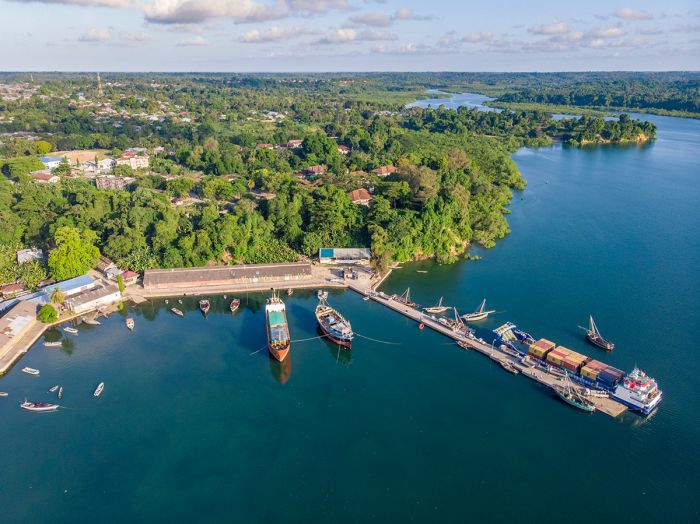
The harbor in Wete, northern Pemba Island, Zanzibar.
Ngezi Forest
Further north is the Ngezi-Vumawimbi Nature Reserve, which is a remnant of the indigenous forest that once covered over half of Pemba, before clove farming was introduced. The forest is rich, with tall teak trees.
Wildlife that can be seen includes some endemic subspecies, including the Pemba vervet monkey, Pemba flying fox, and Pemba blue duiker. Kirk's red colobus were introduced from Unguja and the Javan civet from Southeast Asa. There are four endemic birds found in the forest: the Pemba white-eye, Pemba green-pigeon, Pemba scops-owl, and Pemba sunbird. The forest is considered a sacred place to locals.
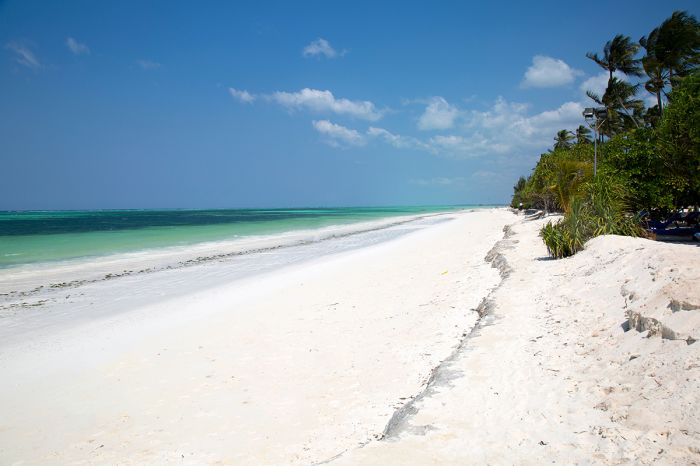
White sand beach on Ras Kigomasha, Pemba Island.
Ras Kigomasha
Pemba's northernmost point, Ras Kigomasha, offers two spectacular and nearly-deserted beaches on either side of the peninsula: Panga ya Wotoro on the west and Vumawimbi on the east. Two excellent lodges are located on Ras Kigomasha.
There are several ruins dating to medieval times in the far north, the best being the Hamisi ruins (also called "Haruni" or Chwaka" ruins). Hamisi dates to the 16th century and is an interesting site to explore.
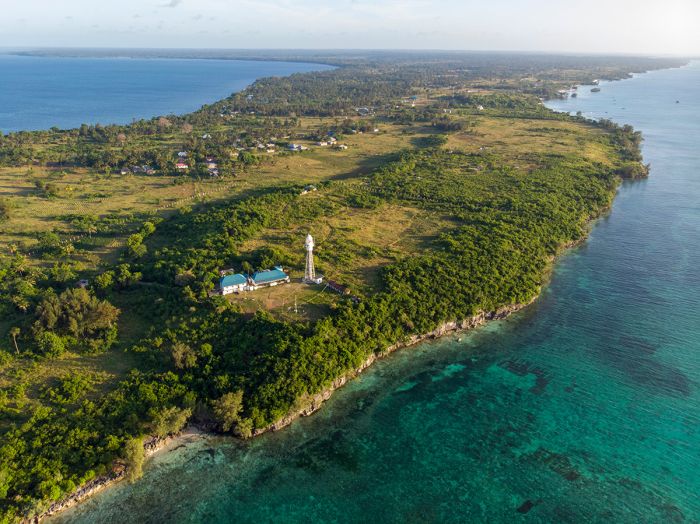
View over the lighthouse at Ras Kigomasha, Pemba Island, Zanzibar.
Diving and Snorkeling
Unguja and Pemba are both excellent for diving and snorkeling, with reefs and smaller offshore islands offering beginner and advanced sites. Pemba in particular is known as one of the world's best places for well-preserved dive sites. Divers will enjoy the massive coral gardens, drop-off reef shelves, and incredible marine life.
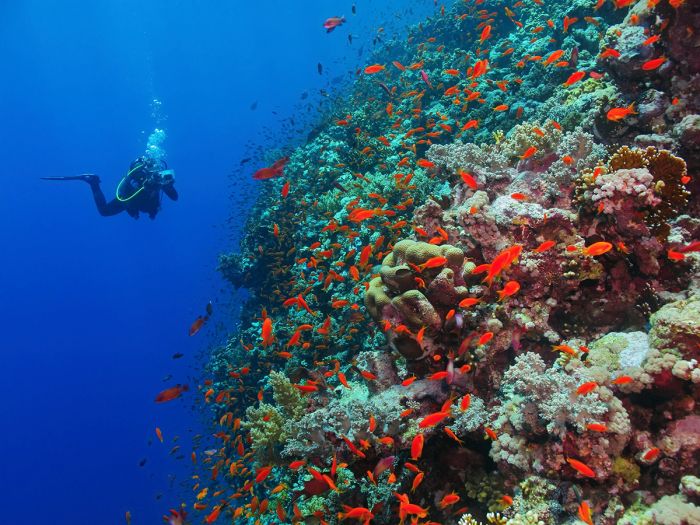
Diving off Pemba Island, Zanzibar.
Diving in Zanzibar is only permitted through one of the many dive centers located on Unguja and Pemba. Snorkeling is available through any accommodation on the islands.
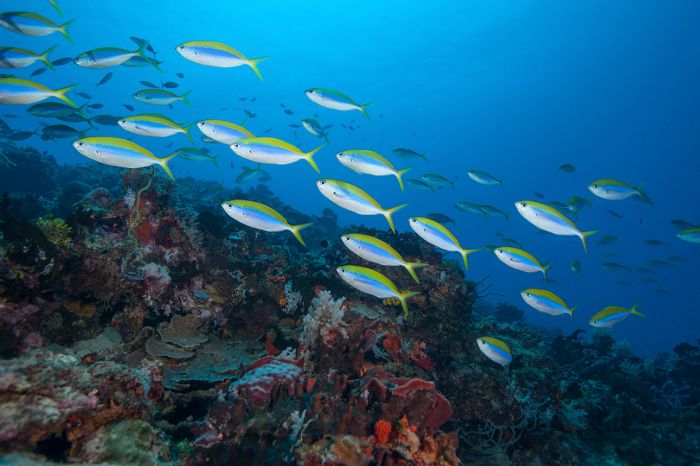
Underwater scene off Pemba Island, Zanzibar.
Read More...
Beaches, Chake, Changuu, Chapwani, Chumbe, Diving, Fumba, History, Jambiani, Jozani-Chwaka Bay, Kendwa, Kiwengwa, Kiwengwa-Pongwe, Kizimkazi, Mahurubi, Mangapwani, Matemwe, Menai Bay, Misali, Mnemba, Mtoni, Ngezi-Vumawimbi, Nungwi, Pemba, Pujini, Ras Kigomasha, Snorkeling, Stone Town, Unguja, Zanzibar Archipelago, Zanzibar City
Great Good Fair Poor
- Jan
- Feb
- Mar
- Apr
- May
- Jun
- Jul
- Aug
- Sep
- Oct
- Nov
- Dec
General Tips
The best time to visit Zanzibar is from June to October, which is the dry season. The same weather patterns of affect most of northern Tanzania, so combining Zanzibar with a safari works quite well in terms of seasonal rainfall. Most visitors prefer to do the safari portion of the trip first, followed by the tropical beaches and air of Zanzibar.
Besides for the period during the 'long rains', which is March through much of May, Zanzibar can be visited at any time without worrying about inclement weather adversely affecting your stay.
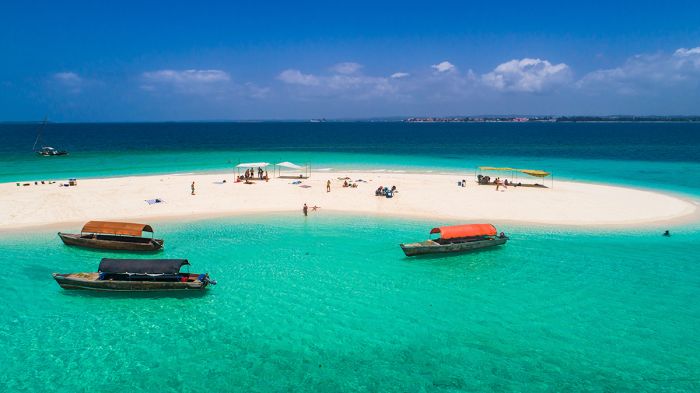
A sand bank offshore from Stone Town, Zanzibar.
Rains
There are two rain seasons in Zanzibar, a less impactful period called the 'short rains', followed by a short dry period and then the heavier 'long rains'. The dry season following the long rains is the best time to visit.
The 'short rains' occur over November and December, with normally light showers occurring sporadically and unpredictably. After these short rains, January and February are normally clear with little to no rain.
The 'long rains' occur from March to May, thanks to the south-west monsoon. Heavy downpours in the afternoon are common during the long rains.
June through October are the driest months, with very little chance of rain. The dry months are an excellent time to visit Zanzibar. August is the driest month and April is the wettest.
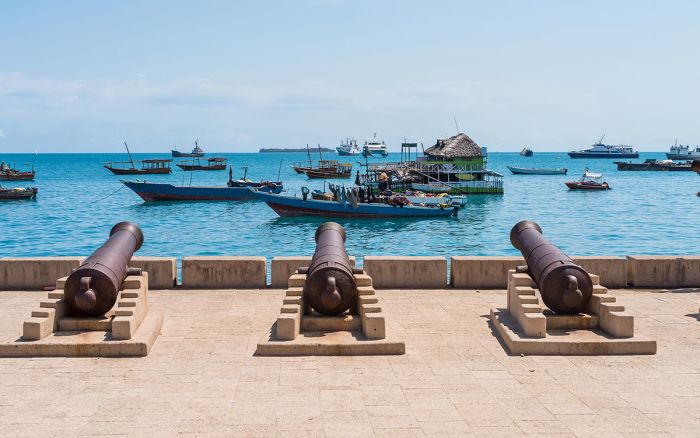
Canons in The Old Fort, Stone Town.
Some beach lodges are closed during the long rains from March thru May.
The islands of Zanzibar are warm all year due to their close proximity to the equator. Over the year, the days average a low of 75°F (24°C) and a high of 84°F (29°C). February and March are the hottest months of the year, while the coolest are from June to August, with daily highs of 83°F (28°C).
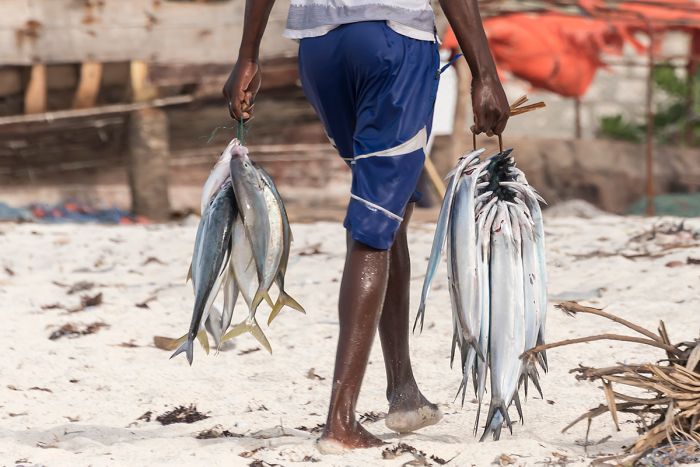
Local Zanzibari fisherman returns with catch.
diving
The best time to visit northern Zanzibar for diving is from June to October, while the south coast is great between November and March.
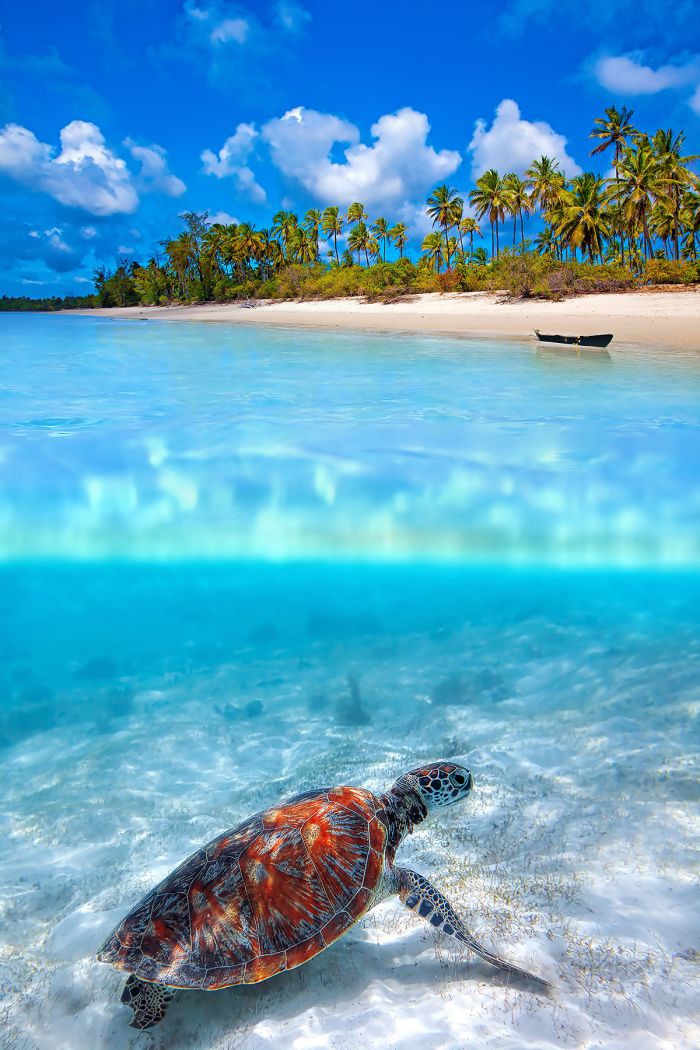
Green sea turtle, Zanzibar.
Showing 1–4 of 4 results
Exclusive and romantic tropical-beach getaway for couples. Large Middle-Eastern-style villas offer total privacy on 50 acres of lush gardens and an exclusive white-sand beach. Fabulous cuisine infused with island flavors.…
Located on the quiet northeast coast of Unguja Island along a calm lagoon and white-sand beach. Endless activities, well-suited to couples, groups, families. Delicious Zanzibari cuisine prepared with fresh ingredients and island spices.…
Romantic villas located on the quiet northeast coast of Unguja Island along a calm lagoon and white-sand beach. Endless activities, plenty of privacy, and a dedicated butler. Delicious Zanzibari cuisine prepared with fresh ingredients and island spices.…




